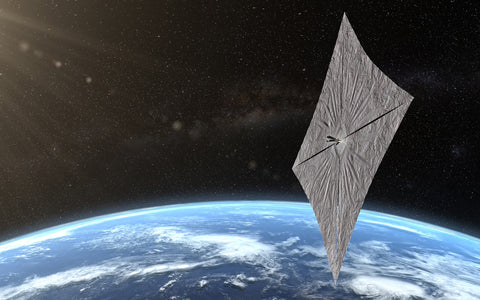This week, a tiny space craft orbiting Earth did something that has never been done before, it sailed through space. It’s called LightSail 2 and is operated by The Planetary Society. Their little craft is a cubesat and it unfurled a sail made of mylar the area of a boxing ring and the weight of a paperclip. The mylar itself is the width of a human hair and instead of wind, it’s sailing on sunlight.
Obviously, there is no wind in space and sailing should be impossible. However, LightSail 2 doesn’t need wind, it relies on particles of light. Photons, which are the particles that make up light, have no mass but they do have momentum. Photons bounce off the solar sail, giving it a little push every time. LightSail 2 will accelerate as long as photons are hitting its sail, enabling it to reach speeds that no chemically powered rocket could ever reach.
The Planetary Society is a public, nonprofit organization whose mission is simply to “empower the world’s citizens to advance science and exploration.” It was co-founded by everyone’s favorite astrophysicist, Carl Sagan, and the solar sail specifically was a dream of his. Today it’s CEO, Bill Nye, explains that the cubesat will “work very much like a sailboat, where you push, twist, and tack into the wind.”
The hope for LightSail 2 is that it will simply prove that solar sailing is a possibility. The technology can be adapted by other space developers to improve upon their existing technology. Since it can maneuver and move without fuel, it’s applications could extend as far as sending cargo to Mars.
One application of the technology already in the works is in Breakthrough Starshot. This is a privately funded mission to send a fleet of these cubesats to visit our nearest stellar neighbor, Alpha Centauri. The mission will take the satellites about 20 years to get there, and they will be powered by lasers as well to help them accelerate to speeds as fast as 60,000 km/s. That’s 20% of the speed of light!
The Planetary Society’s first solar sailing craft, LightSail 1, did not reach an orbit high enough to sail properly. So far, LightSail 2 is showing much more promise. It launched onboard SpaceX’s Falcon Heavy rocket earlier this summer and was deployed once it reached 720 kilometers above the Earth’s surface.
Eventually, LightSail 2 will burn up in the Earth’s atmosphere. Since it’s orbiting the planet, it loses altitude whenever its out of direct sunlight. Eventually, it will dip so low that it will no longer be able to resist the Earth’s gravitational pull. In the meantime, the tiny cubesat’s reflective sail is so bright, it may be visible to the naked eye as it circles the planet. The Planetary Society will be providing updates to let us know when we should look up and keep an eye out for the tiny sailing satellite.






